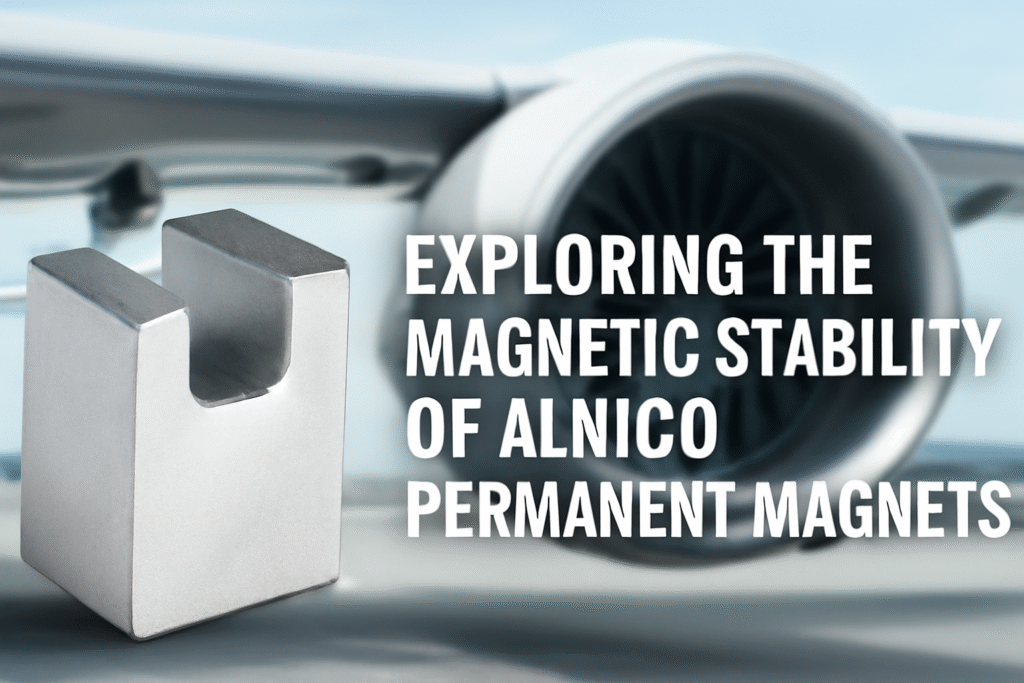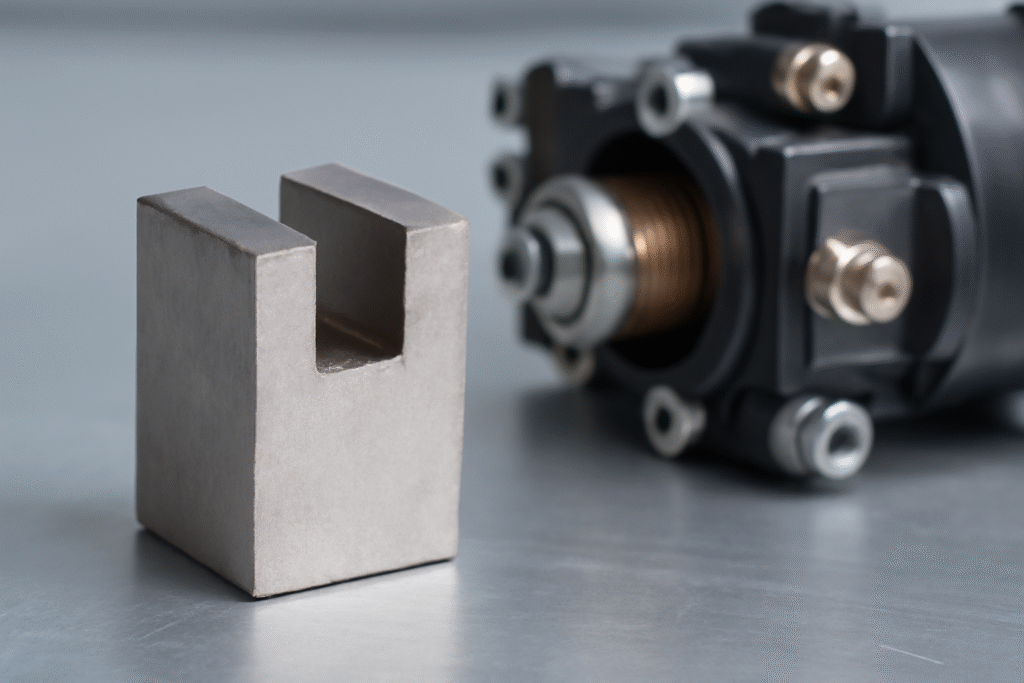Table of Contents

Introduction
In modern aviation, key parts play a big role. They can impact safety, efficiency, and the lifespan of the entire system. One important part is the AlNiCo permanent magnet. It is a key component in hydraulic control systems, like servo valves, used in aircraft. These magnets manage the flow and pressure of fluids in the system. They respond accurately to changes in flight conditions. The magnetic stability of the AlNiCo magnet can be affected by different environmental factors. These include temperature changes, vibrations, and mechanical wear. These factors can reduce their performance over time. This blog post will discuss how to prepare, test performance, and understand AlNiCo magnets in aviation. This is based on recent research.
CORT Magnets is a manufacturer and supplier in China specializing in the research, production, and sales of magnetic materials. If you need an Alnico permanent magnet, please contact us. We will customize the appropriate magnetic material for your project.
What Are AlNiCo permanent magnet?

AlNiCo magnets are a type of metallic permanent magnet made from a mix of aluminum (Al), nickel (Ni), cobalt (Co), and iron (Fe) with small amounts of copper (Cu) and titanium (Ti). These are known for their high-temperature stability and were widely used before the advent of rare-earth magnets like neodymium (NdFeB). AlNiCo permanent magnet can maintain a strong magnetic field even at high temperatures, which is required in applications that need reliable magnetic performance over a long period.
Why Are They Important in Aviation?
In aviation, AlNiCo permanent magnet is used in the hydraulic control systems of various aircraft parts, including servo valves. These valves regulate the flow and pressure of hydraulic fluids in critical systems, including flight controls, engine operation, and fuel management. The accurate operation of these valves is critical for aircraft stability and safety. Since the performance of AlNiCo permanent magnet is directly linked to the precise regulation of these systems, their magnetic properties must remain stable throughout the aircraft’s lifespan, despite environmental stresses such as temperature extremes and mechanical vibrations.
Key Factors Affecting Magnetic Stability in AlNiCo permanent magnet
1. Temperature Sensitivity
Temperature-induced magnetic property degradation is one of the biggest challenges for AlNiCo permanent magnet. Although these materials have high Curie temperatures, they can withstand high temperatures before losing magnetic properties, but exposure to extreme heat or cold for a long time can still cause magnetic decay.
Recent research shows how thermal cycling affects the magnetic properties of the AlNiCo permanent magnet. The study focused on how high-temperature storage (up to 300°C) and low-temperature exposure affect the magnet’s magnetic strength. The result shows that after 60 days of exposure to 300°C, the magnetic flux of the AlNiCo permanent magnet decreased by 3.01%, but the magnet stabilized after that.
This temperature sensitivity highlights the importance of monitoring the condition where AlNiCo permanent magnets are used, to ensure they stay within their optimal temperature range for performance. In aviation, where extreme temperature variation can occur due to altitude change, temperature control is critical for these components.
2. Vibrations and Mechanical Shocks
Mechanical vibrations and shocks are another factor affecting the stability of the AlNiCo permanent magnet. These mechanical stresses can disturb the alignment of magnetic domains in the material and cause temporary or permanent changes in its magnetic properties. This is particularly important in aviation, where aircraft components are subjected to continuous vibrations and sudden shocks due to turbulence, landing, and engine operation.
The vibration testing of AlNiCo permanent magnet showed only a small decrease in magnetic performance after exposure to different levels of vibration, such as 20G vibrations. The residual magnetism, coercivity, and maximum magnetic energy product were within an acceptable range, so the AlNiCo permanent magnet is relatively vibration resistant. But the result also showed that extended or high-frequency vibration can cause minor changes in the magnet’s properties, which can accumulate over time, so a better vibration-resistant design is needed.AlNiCo permanent magnet is naturally resistant to mechanical stress due to its high coercivity, but its magnetic properties can degrade when subjected to sustained vibration or repetitive mechanical shocks. This is especially true when the vibration frequency approaches the natural resonant frequency of the material, which can amplify the mechanical stress. To mitigate this, aviation engineers often use shock absorbers or vibration-damping material to protect sensitive components like magnets.
Microstructure in Magnetic Stability
The microstructure of the AlNiCo permanent magnet is key to its magnetic stability. Microscopic defects, such as inclusions, pores, or improper magnetic phase distribution, can cause loss of magnetic strength. Controlling the microstructure during production is crucial for high-performance and stable magnets.
1. Phase Distribution:
AlNiCo permanent magnet are composed of two main magnetic phases: the α1 phase (strong magnetic phase) and the α2 phase (weaker magnetic phase). The distribution of these phases within the material affects the overall magnetic strength. Improper cooling rates or impurities during production can lead to a cessation of γ phase, which is bad for magnetic stability. Controlling the cooling process and heat treatment allows for ensuring the magnet forms more of the α1 phase and thus higher magnetic strength and stability.
The γ phase is very bad as it causes magnetic losses and remanence (ability of a magnet to retain magnetization) under high temperatures. So advanced casting techniques and controlled cooling rates are necessary to produce AlNiCo permanent magnet that will keep their performance over time.
2. Grain Structure:
The grain boundaries in AlNiCo alloys also affect the magnetic properties. Grain boundary defects can impede the magnetic domain motion, which leads to a reduction of coercivity and overall magnetic strength. Research has shown that grain alignment during production can result in better magnetic properties as it reduces unwanted magnetic domain movements.
The grain structure is influenced by casting temperature and cooling rate during production. A well-aligned columnar grain structure is necessary to reduce the effect of magnetic domain pinning and the coercivity of the material.
3. Elemental Composition:
Besides phase distribution and grain structure, the elemental composition of the AlNiCo permanent magnet also affects the magnetic stability. Elements like titanium (Ti), for example, help to improve the coercivity of AlNiCo permanent magnet by suppressing unwanted phase transitions during cooling. The addition of small amounts of sulfur (S) and silicon (Si) has been found to promote columnar crystal growth, which is essential for better performance of the magnet.
Research shows that titanium (Ti) is key to increasing the magnetic strength of AlNiCo alloys by promoting columnar grains that enhance the magnetic alignment within the material. By balancing the right elements in the alloy, manufacturers can achieve long-term magnetic stability under different operating conditions.
Magnetic Stability Models and Performance Degradation

One of the keys to long-term AlNiCo permanent magnet stability is to understand how the magnetic properties degrade over time. Magnetic decay models allow us to predict how the magnetic flux and gap magnetic fields will change under different conditions, such as temperature changes and vibration.
The Boltzmann curve fitting method is used to analyze the rate of magnetic flux decay over time. By applying this model to the experimental data, we can predict how AlNiCo permanent magnet will perform under different storage conditions, such as temperature cycling or long-term storage at high or low temperatures. This allows engineers to design the system to maintain stable performance throughout the life of the magnets.
Research showed that the magnetic performance degradation of AlNiCo permanent magnet can be modeled with high accuracy. The study found that the rate of magnetic flux decay slows down over time after an initial rapid degradation, and stabilizes after 60 days under extreme temperature conditions. This is very important for aviation applications where reliability and predictability are critical.
Better Stability in AlNiCo permanent magnet
To maintain magnetic stability in AlNiCo permanent magnet, you need both the right material and advanced processing techniques. Recent advancements in precision machining, heat treatments, and casting processes have improved AlNiCo permanent magnet performance.
High Temperature Casting:
One of the biggest advances in AlNiCo permanent magnet manufacturing is high-temperature casting. This allows the material to form columnar crystals, which are essential for the magnetic properties. By controlling the cooling rates and using directional solidification, you can get AlNiCo permanent magnet with better magnetic alignment and higher coercivity and resistance to demagnetization.
This casting process allows for a more uniform and directed crystallization and improves the magnetic properties of the final product. With this process, AlNiCo permanent magnet can withstand challenging operating conditions.
Heat Treatment for Magnetic Alignment:
Another key step to improve magnetic stability is magnetic field heat treatment. During this process, AlNiCo permanent magnet are exposed to specific magnetic fields at high temperatures, which helps to align the magnetic domains better. This results in a more stable and durable magnet even in a harsh environment.
By aligning the domains, this process reduces internal magnetic friction and domain wall movement, and the magnet retains its strong magnetic field over extended use.
Obtain free samples and quotations
Conclusion
AlNiCo permanent magnet are still a key part of critical aviation systems, especially in hydraulic control systems such as servo valves. Their high temperature stability and demagnetization resistance make them suitable for aviation. But maintaining the magnetic stability of these magnets over time is a challenge due to external factors like temperature fluctuations, vibration, and the microstructure of the material itself.
Research has given us a better understanding of how temperature, vibration, and material composition affect the long-term stability of AlNiCo permanent magnet. With advanced manufacturing techniques and predictive modeling, the aviation industry can ensure these magnets will continue to work reliably and keep critical systems safe and efficient.
As technology advances, AlNiCo permanent magnet will get even better reliability, durability, and magnetic stability to meet aviation’s requirements.


